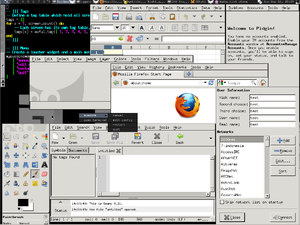AwesomeWM: Difference between revisions
No edit summary |
m (Remove some obsolete/unavailable or just plain nonsensical drivers. Use ic and pkg templates as appropriate. Have setup-xorg-base as a prerequisite..) |
||
| (14 intermediate revisions by 7 users not shown) | |||
| Line 2: | Line 2: | ||
{{TOC right}} | {{TOC right}} | ||
= | = Prerequisites = | ||
* [[Installation|Install]] Alpine Linux | |||
* [[Setting_up_a_new_user#Creating_a_new_user|Create a user account]] (optional but recommended) | |||
* Enable the [[Repositories#Enabling_the_community_repository|Community Repository]] | |||
* [[Alpine_setup_scripts#setup-xorg-base|Install Xorg]] | |||
= Install packages = | = Install packages = | ||
Install awesome, xterm | Install awesome, xterm and terminus font.<br> | ||
Depending on your network speed, it might take a few minutes. | Depending on your network speed, it might take a few minutes. | ||
{{Cmd|# apk add awesome xterm | {{Cmd|# apk add {{pkg|awesome|arch=}} {{pkg|xterm|arch=}} {{pkg|font-terminus|arch=}}}} | ||
== Optional packages == | == Optional packages == | ||
=== Video and Input packages === | === Video and Input packages === | ||
You <u>might</u> want to install a package suitable for your video chipset and input devices.<BR> | You <u>might</u> want to install a package suitable for your video chipset and input devices.<BR> | ||
For example | For example: | ||
{{Cmd|# apk add | {{Cmd|# apk add {{pkg|xf86-input-synaptics|arch=}}}} | ||
{{ | |||
Run | Run {{ic|apk search {{pkg|xf86-video*|arch=}}}} to see available xf86-video packages.<BR> | ||
Run | Run {{ic|apk search {{pkg|xf86-input*|arch=}}}} to see available xf86-input packages.<BR> | ||
===VMWare Users=== | |||
{{Cmd|# apk add {{pkg|xf86-video-vmware|arch=}}}} | |||
and/or | |||
{{Cmd|# apk add {{pkg|xf86-input-vmmouse|arch=}}}} | |||
=== acpid === | === acpid === | ||
| Line 31: | Line 34: | ||
On most systems, xorg should be able to autodetect all devices. However, you can still configure xorg-server manually by launching: | On most systems, xorg should be able to autodetect all devices. However, you can still configure xorg-server manually by launching: | ||
{{Cmd|# setup-xorg-base}} | {{Cmd|# setup-xorg-base}} | ||
= Start your desktop = | = Start your desktop = | ||
| Line 58: | Line 53: | ||
Install dbus from apk (you must be logged in as root for the step shown below) | Install dbus from apk (you must be logged in as root for the step shown below) | ||
{{Cmd|# apk add dbus}} | {{Cmd|# apk add {{pkg|dbus|arch=}}}} | ||
Log in or su to the root account, then launch the following command (Note: sudo does not work for this step): | Log in or su to the root account, then launch the following command (Note: sudo does not work for this step): | ||
| Line 65: | Line 60: | ||
Now if startx is launched, it should load the desktop correctly | Now if startx is launched, it should load the desktop correctly | ||
= = | = See also = | ||
* [[ | * [[Installation#Post-Install|Post Install]] | ||
* [[Desktop environments and Window managers]] | |||
[[Category:Desktop]] | [[Category:Desktop]] | ||
[[ | [[Category:Window Managers]] | ||
[[Category:Lua]] | |||
Latest revision as of 08:20, 13 January 2024

Prerequisites
- Install Alpine Linux
- Create a user account (optional but recommended)
- Enable the Community Repository
- Install Xorg
Install packages
Install awesome, xterm and terminus font.
Depending on your network speed, it might take a few minutes.
# apk add awesome xterm font-terminus
Optional packages
Video and Input packages
You might want to install a package suitable for your video chipset and input devices.
For example:
# apk add xf86-input-synaptics
Run apk search xf86-video* to see available xf86-video packages.
Run apk search xf86-input* to see available xf86-input packages.
VMWare Users
# apk add xf86-video-vmware
and/or
# apk add xf86-input-vmmouse
acpid
If you installed your Alpine Linux as a VirtualBox or VMWare guest, you might find it handy to be able execute an ACPI shutdown.
# rc-update add acpid
Configure xorg-server
On most systems, xorg should be able to autodetect all devices. However, you can still configure xorg-server manually by launching:
# setup-xorg-base
Start your desktop
$ echo 'awesome' >> /home/<newuser>/.xinitrc
$ mkdir /home/<newuser>/.config
$ cp -r /etc/xdg/awesome /home/<newuser>/.config
$ vi /home/<newuser>/.config/awesome/rc.lua
Start awesome.
$ startx
Troubleshooting
D-Bus problems:
D-Bus library appears to be incorrectly set up; failed to read machine uuid: Failed to open "/var/lib/dbus/machine-id": No such file or directory
If startx fails and returns an error about D-Bus failed to read machine uuid, as shown above, proceed as follows:
Install dbus from apk (you must be logged in as root for the step shown below)
# apk add dbus
Log in or su to the root account, then launch the following command (Note: sudo does not work for this step):
# dbus-uuidgen > /var/lib/dbus/machine-id
Now if startx is launched, it should load the desktop correctly